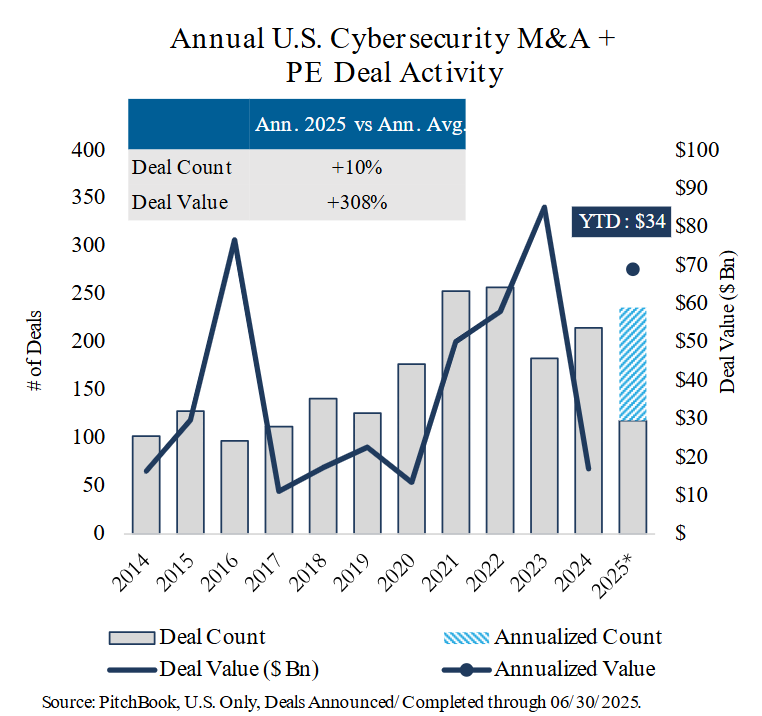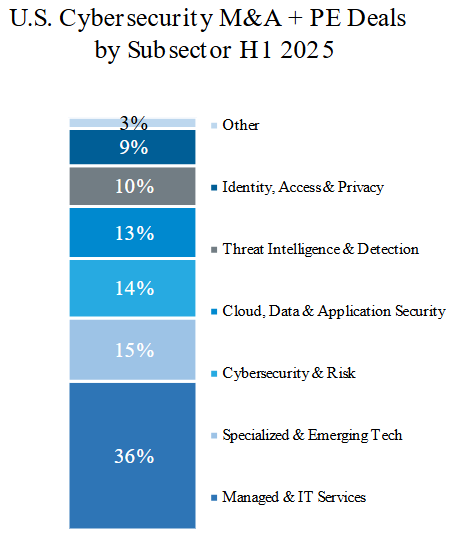What do you think the future holds for the cybersecurity industry? If you’re keeping your ear to the ground, you might have noticed that the world of mergers and acquisitions (M&A) is buzzing. The ongoing evolution in cybersecurity is shaping significant trends, especially as we look toward 2025 and beyond. Let’s unpack these anticipated changes and what they mean for the cybersecurity landscape.

This image is property of jdsupra-static.s3.amazonaws.com.
Projected M&A Activity in Cybersecurity
In the rapidly evolving cybersecurity sector, M&A activity is set to exceed 2024 levels by a substantial 10% in 2025. This isn’t just idle speculation; it reflects the ongoing trend of larger firms acquiring niche players to enhance their capabilities.
Large companies recognize the value of integrating specialized technologies rather than developing them in-house. Niche players often have innovative solutions that can address specific security challenges, making them attractive targets for acquisition. So, what can you expect as this trend takes shape?
The Shift Towards Bigger Transactions
One key detail to note is the increasing prevalence of transactions exceeding $250 million. In this competitive landscape, both strategic buyers—companies looking to strengthen their offerings—and private equity investors are mobilizing to secure high-quality, mature assets. This trend signals a significant point of focus for everyone involved in the industry.
Strengthening Cyber Defenses
The urgency for robust cybersecurity solutions is underlined by a growing recognition of vulnerabilities in various sectors. With cyber threats on the rise, the need for cutting-edge technology and experienced personnel is more essential than ever. Large firms are keenly aware that acquiring established players can provide them not only with technology but also with a skilled workforce, which is a critical aspect of addressing talent shortages.
Driving Forces Behind Cybersecurity M&A
As the industry evolves, several factors are driving the merger and acquisition landscape. Understanding these influences can give you a clearer view of potential developments.
AI Integration and Innovation
Artificial Intelligence (AI) is more than just a buzzword; it’s a game-changer in cybersecurity. The integration of generative and agentic AI technologies is revolutionizing threat detection and automating responses to incidents. As you consider the implications of this innovation, keep in mind how regulatory and geopolitical factors are influencing deal structures.
Organizations are compelled to enhance their offerings to meet the latest compliance requirements and procurement standards. Thus, M&A activity is increasingly tied to firms that can provide advanced AI capabilities.
Geopolitical Influences on Deal Structures
The ongoing shifts in the geopolitical landscape are affecting how deals are structured and which companies are targeted. Heightened tensions can lead firms to prioritize stability and resources that can withstand external pressures.
Private equity firms and public companies alike are keen on companies that can adapt and evolve within volatile environments. The enduring threats from cybercriminal entities necessitate a proactive approach in acquiring firms with innovative solutions.

This image is property of jdsupra-html-images.s3-us-west-1.amazonaws.com.
Q2 2025 Deal Count Observations
As you look at the data from Q2 of 2025, you might notice an interesting trend. The deal count has declined compared to the previous quarter. However, strong performances in both Q1 and Q2 indicate a promising year ahead.
Understanding Deal Fluctuations
While a dip in deal count may raise eyebrows, it’s essential to recognize that these fluctuations are part of a larger cycle in the acquisition landscape. Companies tend to adjust their strategies based on market conditions and the perceived value of potential acquisitions.
These periods of reduced activity often allow firms to reevaluate their approaches and prepare for future opportunities. The strong performance earlier in the year indicates that companies are not shying away from making tactical moves when the moment is right.
A Bright Outlook Ahead
Despite the decline in the volume of deals, the focus on high-value transactions remains steady. As larger firms seek to bolster their defenses and technologies, you can expect notable movements as the year progresses.
Cumulative Deal Value in Cybersecurity
Looking back at 2023, it’s clear that the cybersecurity sector experienced unprecedented financial activity. Significant transactions, such as Broadcom’s whopping $69 billion acquisition of VMware, set a new benchmark in deal values.
Record-Breaking Transactions
The emergence of record-breaking transactions can invigorate the entire sector. These high-profile deals not only draw attention but also signal the ongoing importance of cybersecurity in a world increasingly reliant on technology.
Such moves demonstrate that the industry is willing to put money into what it perceives as vital assets. For investors and stakeholders, understanding these benchmark transactions is crucial for anticipating future trends in the cybersecurity market.
The Impact of Large Transactions on Market Dynamics
High-value transactions often influence market dynamics, driving smaller players to seek an exit or a position in larger firms. Consequently, as the viability of smaller companies fluctuates in this environment, you may find opportunities for investment and partnerships.

This image is property of jdsupra-html-images.s3-us-west-1.amazonaws.com.
Venture Capital Activity Trends
When examining venture capital (VC) activity, particularly in Q2 of 2025, it’s evident that although the deal count has decreased, the deal value has risen. This trend highlights an ongoing focus on proactive measures, particularly in the realms of threat prevention and identity security.
Dissecting VC Deal Count Decrease
The decreased deal count may initially seem concerning, but it often reflects a strategic shift. Investors are becoming more discerning, preferring quality over quantity. They are keen on backing firms that can prove their worth, especially in increasingly specialized sectors.
Rising Deal Values Explained
While the number of agreements may have lessened, the corresponding rise in their value indicates a shift toward larger, more impactful investments. Companies that can demonstrate clear value propositions and measurable outcomes are emerging as prime targets for investment.
The Outlook for the Cybersecurity Sector
The future of the cybersecurity landscape is bright, characterized by strong demand for innovative solutions that can address complex threats. As you analyze projected global cybersecurity spending expected to exceed $1.75 trillion from 2021 to 2025, it becomes clear that key trends will define the trajectory of the industry.
Understanding Cyber Threat Complexity
Complex cyber threats evolve continuously, and businesses face challenges in keeping up with them. This reality drives organizations to seek cutting-edge solutions and prioritize comprehensive cybersecurity measures.
The Impetus for Increased Cybersecurity Investment
The growing complexity of threats indicates that firms across all sectors need to ramp up their security postures. Increased spending on cybersecurity is often a proactive measure to prevent potential breaches that could lead to substantial financial and reputational damage.

This image is property of jdsupra-html-images.s3-us-west-1.amazonaws.com.
Challenges Facing the Cybersecurity Companies
While the outlook is optimistic, several challenges remain for companies in the cybersecurity space. You might wonder what hurdles organizations face as they navigate the intricacies of M&A activity and the broader market.
Demonstrating Clear Value Propositions
To attract strategic M&A interest, companies must effectively convey their value propositions. In an environment where buyers are increasingly careful, demonstrating your organization’s unique strengths will be critical.
Measuring Outcomes Amid Economic Pressures
In pursuing deals, companies must also present measurable outcomes that highlight their effectiveness. With ongoing macroeconomic pressures, stakeholders are gravely interested in understanding how organizations achieve performance amidst challenges.
Attracting Cybersecurity Talent
The cybersecurity landscape is not just about fancy technology; it thrives on talent as well. With a talent shortage in cybersecurity professionals, companies must consider innovative approaches to attract and retain skilled workers.
Future Trends in Cybersecurity M&A
As the cybersecurity landscape continues to evolve, several critical trends are expected to shape the future M&A activities. These include a growing emphasis on AI integration, the surge in demand for cloud security, and the adoption of zero-trust architectures.
The Integration of AI and Automation
The significance of AI in cybersecurity cannot be overstated. Integration of AI-driven solutions is expected to not only streamline threat detection but also automate responses, which is crucial for mitigating risks in real-time.
The Surge in Cloud Security Demand
With an increasing number of organizations migrating to cloud solutions, the demand for enhanced cloud security measures is skyrocketing. This shift is essential for maintaining data integrity and security in an even more connected world.
Zero-Trust Architectures as a Standard
The adoption of zero-trust architectures is becoming a best practice in cybersecurity. This approach assumes that threats could originate from within and outside the network, prompting organizations to rethink traditional security protocols.
Anticipating Continued M&A Activity
As we look toward the near future, it’s safe to say that M&A activity in cybersecurity will remain brisk. You can anticipate ongoing collaborations, investments, and acquisitions centered around technology solutions that address evolving cyber threats.
This ongoing activity will not only shape how companies are structured but also how they address the vulnerabilities and challenges that permeate the industry.

This image is property of www.jdsupra.com.
Conclusion: Preparing for the Cybersecurity Future
In reflecting on the trends shaping the future of cybersecurity M&A, it’s essential to keep a vigilant outlook. The market will continue to evolve, driven by innovation, regulatory changes, and geopolitical factors. As you navigate these changes, consider how you can remain proactive, stay ahead of emerging threats, and ensure your organization is well-positioned for the future.
The anticipation of continued M&A activity in cybersecurity underscores the importance of agility, innovation, and strategic investment. By understanding these trends and acknowledging the complexities involved, you can be better prepared for the challenges and opportunities that lie ahead in the cybersecurity landscape.